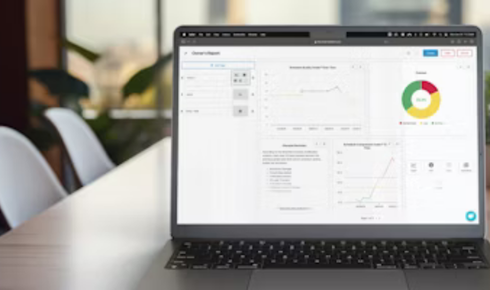Building Smarter, Faster, Stronger: Why the Future of Construction Management Is Digital
September 26, 2025

Construction has always been about vision meeting execution. You’ve got a design on paper, a client with expectations, and a crew tasked with turning concrete, steel, and sweat into something that’ll last for decades. But if you’ve spent any time around job sites lately, you know the building itself is only half the battle. The other half is organization — managing people, time, and money in a world where delays and overruns are almost a cliché. That’s where technology quietly sneaks in and changes the game.
We’re not just talking spreadsheets anymore. The industry has been moving toward tools that don’t just record data but actively help guide decisions. The result? Projects that finish closer to schedule, stay within budget, and reduce those late-night phone calls nobody wants to get.
The Pain Points We Don’t Talk About Enough
If you’ve ever been involved in construction, you already know the chaos. Weather delays. Supply chain hiccups. A subcontractor running late. Miscommunication between architects, engineers, and site managers. Every day feels like a puzzle, and not the fun kind you do on a Sunday morning.
It’s no wonder so many projects creep over deadlines and bleed money. And the frustrating part? Much of it comes down to mismanaged information. Data that sits in silos. Updates that don’t reach the right people at the right time. Manual tracking that looks fine on paper but falls apart once reality hits the site.
That’s the crack modern tools are trying to fill. And, frankly, it’s about time.
Where Software Steps In
Here’s the thing: construction project management software isn’t about replacing experience or gut instinct. Those still matter. What it does is put every piece of the project puzzle in one place. Scheduling, budgets, resource allocation, risk tracking — instead of being scattered across emails, sticky notes, and five different apps, it’s centralized.
Think about how powerful that is. A site manager can instantly see the financial impact of a delay. A project owner can check progress in real time without making ten calls. An engineer can upload updated drawings and know the crew has the latest version — not last week’s outdated plan.
It doesn’t eliminate problems, but it shrinks the chaos into something manageable. And that’s the difference between projects limping to the finish line and projects crossing it with confidence.
Why Scheduling Deserves Its Own Spotlight
Among all the moving parts, time is the most slippery. Materials can be bought. Labor can be hired. But time? Once it’s gone, it doesn’t come back. That’s why construction scheduling software has become the backbone of many project teams.
Instead of static Gantt charts taped to office walls, modern scheduling tools are dynamic. They adapt when something shifts — because something always shifts. A delayed delivery doesn’t just sit as a red mark on the chart; the software recalculates downstream impacts and shows what’s at risk.
It’s not about predicting the future. It’s about being prepared for it. When you know the ripple effects of a two-day delay, you can make decisions faster and more confidently. That’s a far cry from the “let’s wait and see” approach so many teams still lean on.
A Closer Look at SmartPM
Not all tools are created equal. Some claim to be all-in-one solutions but end up being clunky or too generic. Others nail one function but leave you scrambling with add-ons. That’s why SmartPM software has been making waves.
It’s built specifically for construction, not adapted from some generic project management platform. What stands out is how it handles schedule analytics — identifying risks early, comparing baselines to actuals, and surfacing insights you’d probably miss with manual tracking.
Project leaders don’t just get raw data; they get context. The kind that helps explain why a project is slipping before it turns into a disaster. And if you’ve ever sat in a meeting trying to justify why costs are ballooning, you know how valuable that kind of clarity is.
The Cultural Shift Behind the Tools
Of course, adopting new technology isn’t just about clicking “install.” It’s about mindset. The construction industry has been notoriously slow to embrace digital tools, partly because the old ways “worked well enough.” But the truth is, the stakes are higher now. Clients expect faster turnarounds. Regulations get stricter. Margins get tighter.
Younger professionals entering the field don’t just prefer digital tools — they expect them. They’ve grown up with apps that track everything from personal finances to daily workouts. Asking them to manage a multimillion-dollar project on spreadsheets feels like asking a pilot to navigate with a paper map instead of GPS.
Change is happening not because tech companies are pushing it, but because the ground reality demands it.
Real-World Wins
Let’s get practical. A mid-sized contractor in the Midwest implemented new scheduling and project management tools on a school renovation project. Historically, their projects ran about 12% over budget. This time? They came in just 2% over — and most of that was tied to an unexpected materials price hike, not mismanagement.
Another firm handling commercial developments in Texas used real-time analytics to flag a high-risk subcontractor early in the project. They swapped crews before the delays stacked up, saving weeks of headaches and avoiding costly penalties.
These aren’t isolated stories. They’re becoming the new normal for teams that lean on digital help rather than stubbornly sticking to the old ways.
So, Where’s This All Heading?
If the past decade was about introducing tech into construction, the next one will be about making it smarter and more predictive. Artificial intelligence is already being layered on top of project data to spot patterns humans might miss. Cloud-based collaboration means everyone — from the architect sipping coffee in the office to the electrician standing on scaffolding — can work off the same source of truth.
We’re also likely to see more integration between different platforms. Imagine your procurement system automatically syncing with your project schedule, so material orders are triggered exactly when needed, reducing both shortages and storage costs. That’s not some distant dream; it’s already in development.
Wrapping It Up
At the end of the day, construction is still about people building things. No software replaces the judgment of a seasoned foreman or the creativity of an architect. But digital tools are making the work more predictable, less stressful, and, frankly, more successful.
So the next time you hear someone complain about software creeping into construction, remind them it’s not about replacing the hammer — it’s about making sure the hammer lands at the right time, in the right place, with the right budget.
The future of building isn’t just taller skyscrapers or greener homes. It’s smarter ways of managing the messy, complicated process of getting there. And if the current wave of digital adoption is any clue, that future’s already under construction.
